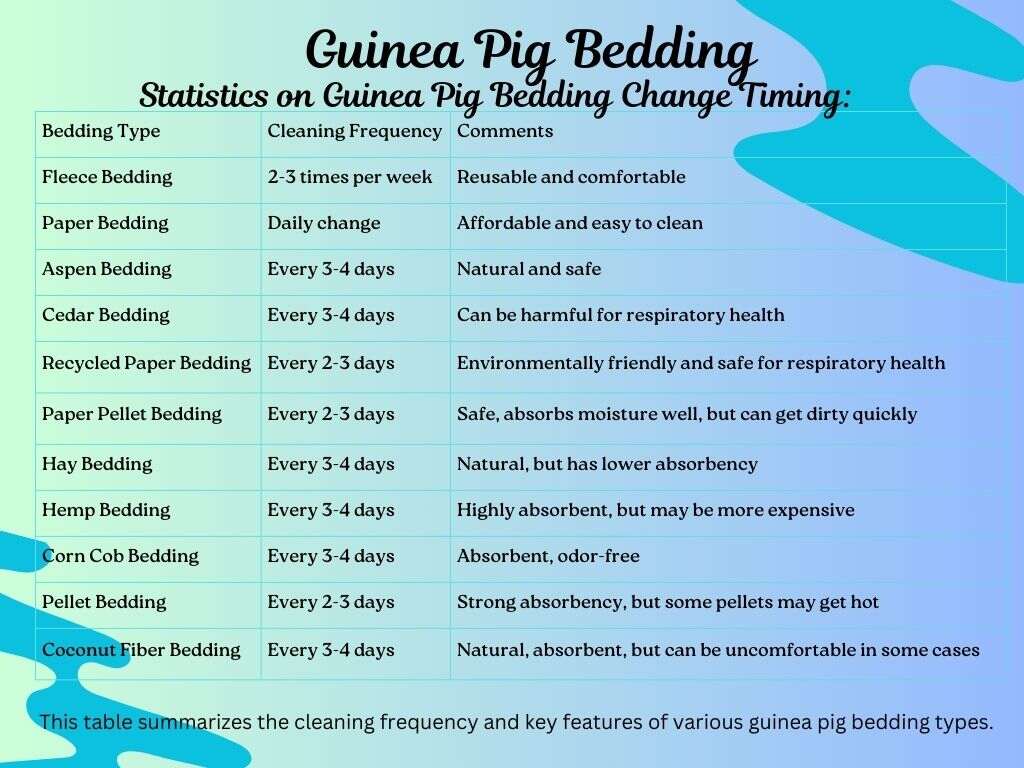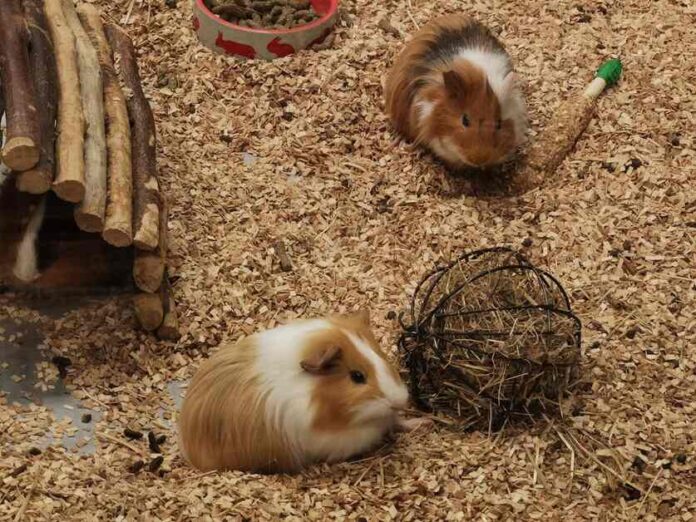Choosing the right bedding for your guinea pig will help them stay healthy. We will discuss the problems they face without a bed, the pros and cons, and many other relevant topics. We hope you find it useful.
Why Do Guinea Pigs Need Bedding?
Absorbs waste: Guinea pigs excrete urine and feces in their homes, which creates a damp environment inside. This causes odors and the growth of various types of bacteria, which are harmful to their health. Bedding helps absorb this urine and feces. As a result, the environment around the guinea pigs remains clean and dry.
Provides comfort: Guinea pigs spend most of their day sleeping. Wild guinea pigs like to burrow in the ground to sleep, which gives them a soft feel. Soft and comfortable bedding in the cage helps them satisfy this natural instinct.
Maintains hygiene: Using bedding makes it easier for guinea pigs to maintain their hygiene. This protects them from the discomfort of hard floors and the risk of bacteria that accumulate on the floor.
Protects the cage: The floor of the cage can be easily damaged by the movement, urine, and feces of guinea pigs. Using the right bedding will help the floor of the cage last longer and will not require additional repairs.
Temperature control: It is very important to control the body temperature of guinea pigs, because they can easily get sick in cold or hot environments. The risk of hypothermia increases in cold weather and heatstroke in hot ones. Therefore, it is essential to choose the right and comfortable bedding for them.
The Different Types Of Guinea Pig Bedding

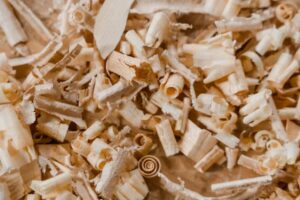
Wood shavings
Advantages: Pine bedding is popular with many pet owners because it is affordable and readily available. It quickly absorbs urine and odors from the cage, keeping the cage clean for a long time. In addition, its natural wood texture makes the cage look beautiful and comfortable. Moreover, it is environmentally friendly and can be used as compost.
Disadvantages: However, the natural oils (phenols) contained in pine wood are hazardous to guinea pigs’ respiratory system. Using dusty shavings can harm their health. In addition, highly abrasive shavings can cause injuries to guinea pigs’ feet. In addition, it takes longer to decompose than other options.
Comments: If you want to use pine bedding, be sure to choose kiln-dried and dust-free shavings. This provides comfort to guinea pigs and keeps them safe. Using pine shavings mixed with hemp gives better results. When used correctly, it can be an effective and environmentally friendly option.
Aspen Bedding
Advantages: Aspen bedding is much safer than pine and cedar, which is ideal for guinea pigs. It does not contain any harmful oils, making it completely safe for their respiratory system. In addition, it is softer and more comfortable than other wood shavings. Aspen bedding is a great choice for guinea pigs for comfort and safety.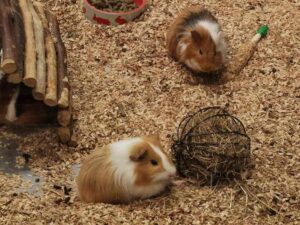
Disadvantages: However, aspen bedding can be a bit expensive, which can be a problem for budget-conscious pet owners. It is also less readily available than other options. Additionally, aspen bedding can be a problem if it is not completely dust-free.
Comments: If budget is not a big issue for you, aspen bedding is a great choice. You can mix it with other shavings, such as flax. This method reduces costs and ensures a more comfortable environment for guinea pigs.
Cedar Bedding
Advantages: Cedar bedding is readily available and highly absorbent, which helps keep the cage dry. It is effective in reducing odors in the cage. Many people prefer it because of its natural scent. Additionally, cedar bedding is attractive to look at and convenient to use.
Disadvantages: However, cedar bedding can be risky for guinea pigs. The natural oils (phenols) it contains can cause respiratory problems. This can negatively affect their health over the long term. If not processed properly, it can be even more harmful.
Comments: If you prioritize the health of your guinea pig, it is best to avoid cedar bedding. If you must use it, choose only kiln-dried cedar, as this process removes harmful oils. Look for safer and softer materials as alternatives.
Paper Bedding
Advantages: Recycled paper bedding is a safe and environmentally friendly option for guinea pigs. It is very soft, absorbent and dust-free, which is ideal for guinea pigs’ comfort. In addition, being dust-free, it is particularly beneficial for their breathing. It is a good choice for owners who care about the environment.
Disadvantages: However, recycled paper bedding can be a bit more expensive than other bedding. Since it is expensive, many people who are concerned about the budget may avoid it. Also, it needs to be replaced quickly if it gets too wet.
Comments: If your guinea pig has sensitive respiratory system, paper bedding is an ideal option. Its soft and dust-free qualities ensure a comfortable and safe environment for them. If you use it, pay attention to cleaning it regularly to maintain your pet’s comfort.
Paper Pallet Bedding
Advantages: Paper pallet bedding is a reusable and safe option, which is especially useful for guinea pigs. It helps to avoid respiratory problems as it is soft and dust-free. In addition, it is environmentally friendly and can be a comfortable option for your guinea pig.
Disadvantages: However, paper pallet bedding has a slightly lower absorbency, which can be problematic for long-term use. It can accumulate waste quickly if used alone. Therefore, it is best to replace it or use it with other absorbent bedding.
Comments: If you are looking for a soft and breathable bedding, paper pallet bedding is a great option. However, to increase its absorbency, mix it with other absorbent bedding. This will keep your guinea pig’s habitat more comfortable and clean.
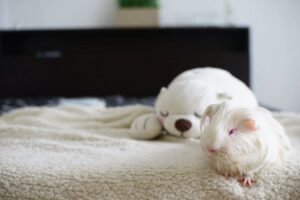
Fleece Bedding
Fleece bedding is usually made of polyester fabric. Because of this, it is very soft and light, so guinea pigs feel comfortable and comfortable to stay in. Very helpful and economical, especially for those who keep them in C&C cages
Advantages:
One of its advantages is that it is comfortable and smooth for the skin.
Easy to clean. It can be washed and reused.
There is less dust. , which reduces the risk of allergies.
It can be used for a long time.
Disadvantages:
Needs to be cleaned regularly or it can smell bad. If you want, you can wash it every 7 days. In that case, you can buy 2. If you wash one, you can use the other.
Hay bedding (Timothy Hay, Orchard Hay)
Hay bedding has been used since ancient times, which guinea pigs like to eat and lie on. The problem with this is that it gets messy quickly and the hay gets wet due to urine. You can mix absorbent materials with this hay if you like.
Hemp Bedding:
Hemp bedding is also highly absorbent. Perfect for guinea pigs that have breathing problems. Although it is a bit expensive, it is a comfortable and healthy option for guinea pigs.
Corn shell bedding
Corn shell bedding is light and absorbent, but it can be harmful to guinea pigs if they chew it, which can cause intestinal blockage. Therefore, caution should be taken when using it.
Pellet Bedding And Coconut Fiber Bedding
Pellet bedding and coconut fiber bedding are highly absorbent and help control odors. However, pellet bedding is not as soft as other bedding, and guinea pigs may not like it.
What Size Should A Guinea Pig’s Bedding Be?
Required size: The size of a guinea pig’s bedding should be based on their body size. Generally, the bedding should be 1.5 times the size of the guinea pig’s body so that they can lie down or rest comfortably.
Minimum size: The size of a single guinea pig’s bedding should generally be 30×50 cm, but they will enjoy more space if kept in a larger space.
Size for multiple guinea pigs: If you have more than one guinea pig, you should use a larger size bedding to provide enough space for them. For example, 60×90 cm or larger.
Material and Texture
Soft Padded Design: The bed should be soft padded so that the guinea pig can lie comfortably. This helps reduce pressure on their body.
Reusable and Clean Design: The design should be such that it can be easily cleaned. This is especially important to reduce the chances of dirt or bacteria building up in the guinea pig bed.
Dry Environment Inside: Guinea pig beds should not have too much moisture or a wet environment, as this can be harmful to their health. The design should be such that a dry and clean environment is maintained.
Additional Features
Flip-over convenience: Many beds have designs that can be used on one side when there is a gap or leak. This can be more effective for the guinea pig and convenient for cleaning.
Extra Compartments: Some designs have additional small compartments or shelves for the guinea pig, where they can keep their food or toys. This allows the guinea pig to keep their belongings separate.
Where To Find The Best Guinea Pig Beds And Why
The best beds for guinea pigs are available online and offline. Some popular places are: Amazon
Why: There are different brands and types of guinea pig beds available here. You can easily compare prices and reviews to choose the best bed.
Tip: Amazon Prime members get fast delivery.
Fragrances In Guinea Pig Bedding
Scented bedding should not be used for guinea pigs, as it can cause respiratory problems. Many times it contains chemical ingredients, which are harmful to the respiratory tract and skin of guinea pigs. Therefore, choosing natural and unscented bedding is better for their health and comfort.
Materials To Avoid For Guinea Pig Bedding
There are a few materials to be wary of when choosing bedding for guinea pigs, as they can be harmful to your pet’s health:
Cedar shavings or non-kiln-dried pine shavings: The aromatic oils in these can be toxic to guinea pigs, so avoid them. Use aspen shavings instead.
Sawdust: The dust poses a respiratory hazard, so it is not suitable for guinea pig bedding.
Newspaper: It lacks absorbency and is not suitable for guinea pigs. However, you can use it as a liner under the bed.
Disposable puppy pads: These can be unsafe for guinea pigs, as guinea pigs can chew them and cause internal blockages.
Hay: Although guinea pigs like to sleep in hay, it should not be used as the main bedding material due to its lack of absorbency. However, it can be added to specific areas of the guinea pig’s cage to enrich the environment.
Cat litter: This is harmful to guinea pigs and can be dangerous to their respiratory system.
Pellet bedding: While pellet bedding is good for absorption, it is not comfortable for guinea pigs and should not be used as the main bedding material.
Statistics On Guinea Pig Bedding Change Timing
